FESTIVALPROGRAMM BLOG
AUSZÜGE IN DEUTSCHSIMPLICITY - the art of complexity - ARS ELECTRONICA 2006 - Festival für Kunst, Technologie und Gesellschaft - Linz, Do 31. August – Di 5. September
23
Jul
 © rubra
© rubra
The Upgrade! is an international network of gatherings concerning art, technology and culture. As an emerging network of autonomous nodes committed to bridging cultural divides, The Upgrade! operates along an axis of simplicity, by sustaining a monthly gathering format, and as a space for artists to present and share their work. As an international organisation, the network engages complex problems as it struggles to find a model for decision-making, representation, funding, organisation and growth within trusted community-based collaborations. The Upgrade! began in 1999 with a regular gathering in New York City organised by Yael Kanarek. Upgrade! New York partnered with Eyebeam in 2000, and in 2004 The Upgrade went international with Vancouver and Montreal, followed by over a dozen worldwide locations in 2005 (and growing!). The first Upgrade! International Gathering was held in September 2005 in NYC at Eyebeam, with representatives from each node, and the second will be held in Oklahoma City, USA, from November 30th–December 3rd, 2006.
www.theupgrade.net
Current Nodes: AMSTERDAM (Lucas Evers / Nat Muller); BOSTON (Jo-Anne Green); CARACAS (Yucef Merhi / Deborah Mizrahi); CHICAGO (Tiffany Holmes / Lincoln Schatz); ISTANBUL (Emre Erkal / Erhan Muratoglu / Basak Senova / NOMAD); JOHANNESBURG (Christof Doherty / Nathaniel Stern); LISBON (Luís Silva); MONTREAL (Anik Fournier / Sophie Le-Phat Ho / tobias c. van Veen) _ MUNICH (Tamiko Thiel); NEW YORK (Yael Kanarek / Jesse Pearlman Karlsberg / Liz Slagus); OKLAHOMA CITY (Adam Brown); SALVADOR (José Balbino / midiatatica.org / Oitininha); SCOTLAND (New Media Scotland); SEOUL (Suhjung Hur); SKOPJE (Antonio Dimitrov / Elena Veljanovska); SOFIA (Petko Dourmana / Ivaylo Ivanov / Yana Kostova / Yovo Panchev); TEL AVIV / JERUSALEM (Salamanca / Mushon Zer-Aviv); VANCOUVER (Kate Armstrong); WELLINGTON (Marcia Lyons)
Future Nodes: ATHENS (Daphne Dragona); BELGRADE (Maja Ciric / Jasmina Maric / Zana Poliakov); BERLIN (Public Art Lab); LIVERPOOL (N.N.); PARIS (Incident.net); VIENNA (Ursula Hentschlaeger / Zelko Wiener)
22
Jul
![]() © rubra
© rubra
The urban domain is being infrastructurally upgraded into a multimedia environment as digitization makes its physical mark on the cityscape itself.
Architecture is being endowed with medial qualities and equipped with everything from telematic furnishings to location-based services, elements that constitute interfaces between virtual and material spheres of communication. Creative confrontations beyond the realm of advertising messages and décor betoken growing consciousness of the mediatization of society.
The results of these encounters integrate themselves into their environment as subtle interventions, but also as the fulfillment of tasks on a mundane agenda. Media art’s manifesting itself beyond the confines of the museum-exhibition context as a component of a piece of architecture or in the form of telematic environmental design has been accompanied by the emergence of a new quality being exhibited by installations.
A criterion of particular relevance to this category of (in many cases interactive) projects is user involvement in a way that is as intuitive as possible: a mode of functioning that proceeds as a matter of course without in any way diminishing the expressiveness of the project itself.
At the 2006 Pixelspaces Conference, practitioners in this field will participate in an open discourse focusing on the challenges that (media) designers see themselves confronted with as a result of the emergence of the “real-time city.”
22
Jul
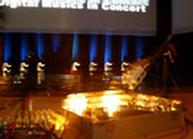 © rubra
© rubra
Eliane Radigue (FR), the Golden Nica recipient in the Digital Musics category, Joe Colley (US) and other Prix Ars Electronica prizewinners are conceiving and putting on a very special concert featuring live performances.
L’île re-sonante
According to Eliane Radigue, “L’îIe re-sonante” (The Resonating Isle) was inspired by a moment in which the musician saw an island in a lake while the water reflected her face. Such an image is two elements in one—a “real” picture and an optical illusion. The depth of the water is reflected by the deeper tones; the higher tones float above them like the island jutting out of the water.
Eliane Radigue emphasizes the transparency on which the work is primarily based, and cites as an additional source of inspiration the moment at which the last strains of a piece of music resonate in listeners’ ears while they simultaneously prepare to partake of new sounds—a fleeting moment that extends “no longer” and anticipates “not yet.”
Eliane Radigue composes electro-acoustic music. In the early ‘50s, she was one of the pioneers of this genre (together with Pierre Schaeffer and Pierre Henry). The same consistency and economy with which she works exclusively with an ARP synthesizer has characterized her musical mode of expression for decades. Lately, she has been discovered as a model by a younger generation of musicians.
Eliane Radigue (FR) - Goldene Nica Digital Musics: L’île re-sonante
Joe Colley (US) - Distinction Digital Musics: psychic stress soundtracks
Yvonne Cornelius (DE) - honorary mention Digital Musics: Niobe
Emanuel Jauk (AT) - honorary mention u19 - freestyle computing
Joe Colley (US)
Eliane Radigue (FR
21
Jul
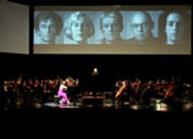 © rubra
© rubra
7:30 PM, Lentos
Ludger Brümmer: Move - for piano, live electronics and video (Premiere)
8:30 PM, Brucknerhaus, Main Hall
Philippe Manoury: Sound and Fury, for a full orchestra (1999); John Cage: Concerto for Prepared Piano and Chamber Orchestra (1951)
Performers: Maki Namekawa and the Bruckner Orchestra Linz conducted by Dennis Russell Davies
9:30 PM, Klangpark
Sonic Projections
10 PM Brucknerhaus
Charles Amirkhanian: Loudspeakers (for Morton Feldmann), (1990)
10:40 PM
Ryoichi Kurokawa: audiovisual crossmedia concert
11:10 PM
Naut Humon
Charles Amirkhanian (US)
Brucknerorchester Linz (AT)
Ludger Brümmer (DE)
John Cage Dennis Russell Davies (US)
Naut Humon (US)
Ryoichi Kurokawa Philippe Manoury Maki Namekawa (JP)
21
Jul
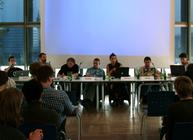 © Sabine Starmayr
© Sabine Starmayr
Over the last 10 years, completely new preconditions have become operative in the media with respect to information development and the possibilities of actively expressing and disseminating opinions. The media world’s complexity has increased exponentially through the emergence of network media like weblogs and wikis.
Lisl Ponger (AT)
Johannes Schnizer (AT)
20
Jul
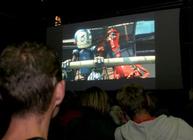 © Quelle: rubra
© Quelle: rubra
A big-screen showing of the prizewinning works in the 2006 Prix Ars Electronica’s Computer Animation / Visual Effects category.
458nm - Jan Bitzer, Ilija Brunck, Tom Weber / Filmakademie Baden Württemberg (DE)
Kein Platz für Gerold - Daniel Nocke (DE) / Studio FILM BILDER
NEGADON: The Monster from Mars - Jun Awazu (JP)
Kakurenbo: Hide and Seek - Shuhei Morita, Shiro Kuro (JP) / YAMATOWORKS
MTV: “Crow” - Marco Spier, Marie Hyon (US) / PSYOP
renaissance - Christian Volckman (FR) / onyx films
The Regulator - Philippe Grammaticopoulos (FR)
Discord: metal and meat - Stephan Larson (US)
Strasse der Spezialisten - Saschka Unseld, Jakob Schuh (DE) / Studio Soi GmbH & Co. KG
Co-production cine plus Media
CAFARD - Thomas Leonard, Guillaume Marques, Paul Jacamon (FR) / SUPINFUCOM
Als ich hier angekommen bin - Perrine Marais (DE) / Filmakademie Baden-Württemberg
Rexona – Stunt City - The Mill (UK)
Shinsatsu-Shitsu (Consultation Room) - Kei Oyama (JP)
Sin City - Stu Maschwitz (US) / The Orphanage
ONE MAN BAND - Mark Andrews, Andrew Jimenez (US) / Pixar Animation Studios
20
Jul
Events, Concerts & Performances | posted by MariaHieslmayr | at 09:08:00
Visualisierte Linzer Klangwolke
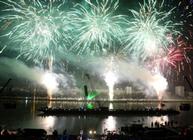 © Quelle: rubra
© Quelle: rubra
The situation of the world’s children is the theme of the 2006 Klangwolke (cloud of sound). Dutch songwriter and poet Herman van Veen will personally relate in word and song the story of Alfred Jodocus Kwak, a duck who’s involved as UNICEF’s ambassador for children’s rights. The 60th anniversary of the United Nations children’s aid organization also provides a fitting occasion for the Klangwolke to go into the living conditions of children around the world.
Hermann van Veen (NL)
19
Jul
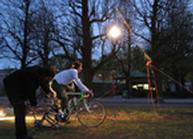 © Assocreation
© Assocreation
On Linz’s Main Square, cyclists will be hooking up their bikes to one of the many generators set up there waiting for them to provide the muscle power needed to charge a giant battery. Each revolution of every set of pedals moves the battery charge indicator a little closer to full. At a prearranged time after sundown, the cyclists’ output will be switched directly to a balloon floating above; the harder they pedal, the brighter the artificial moon glows in the night sky. The humming of the muscle-powered generators will spread out a blanket of sound across the square. During the night, the battery charged during the day will discharge and the moon will gently set over Linz.
Assocreation (AT)
19
Jul
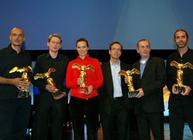 © Quelle: rubra
© Quelle: rubra
An evening totally devoted to the artists. The grand opening event is the first highlight of the 2006 Festival. At the top of the evening’s agenda: presentation of the Golden Nicas to the Prix Ars Electronica prizewinners.
18
Jul
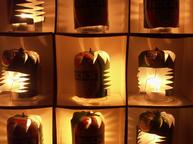 © Aram Bartholl
© Aram Bartholl
Each individual pixel of Random Screen is an independent unit. Core components are a projection foil, a modified beer can and a small tea candle. The candle serves as a source of light; at the same time, the warmth it gives off sets the modified beer can in motion. The can, modified into a sort of freely rotating fan mounted above the candle, can spin around freely. The candlelight shines through a window cut in the beer can onto a projection surface and makes the pixel light up. Depending on how fast the fan spins, it turns the respective pixel either on or off. The larger the candle’s flame, the brighter the pixel shines and the faster its switching frequency. The candlelight is diffused on a second projection foil in the middle of the pixel box in order to make it possible to brighten or dim the pixel as gently as possible. The individual pixels stacked on top of and next to one another form the Random Screen. The small format of the pixels allows the surface of the screen to be expanded at will and this construct’s simple components make it easy for others to copy.
Aram Bartholl (DE)
18
Jul
 © Tsuyoshi Ozawa
© Tsuyoshi Ozawa
Following in the footsteps of Dada and Fluxus artists, Ozawa adapts subcultural visual languages to suggest political and social transformation and uses humor and interaction to break down stereotypes. In Museum of Soy Sauce Art, 1998-2000, he used soy sauce as a drawing medium to create parodies of historical Japanese masterpieces. The ongoing work, Vegetable Weapon, begun in 2001, presents photographs of people holding foodstuffs arranged in the shape of a gun. Each of these “weapons” composed using the ingredients of that person’s favorite local dish. That a gesture of conflict can become an opportunity for sharing suggests that enmity and friendship sometimes represent two side of the same coin.
Tsuyoshi Ozawa (JP)
17
Jul
Events, Concerts & Performances | posted by MariaHieslmayr | at 15:49:00
The Cell Atlantic CellBooth
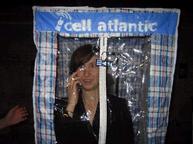 © Jenny Chowdhury
© Jenny Chowdhury
The portable phone booth, which I call the "Cell Atlantic CellBooth", is a wearable object you can carry around with you and set up when you need a moment to talk. The project prompts people to take stock in how cell phone technology has altered the ways in which we communicate with each other and the environment surrounding us.
Jenny Chowdhury (US)
17
Jul
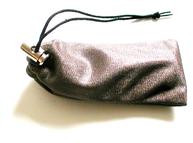 © Aram Bartholl
© Aram Bartholl
The “Silver Cell” cell phone carrying case works like a Faraday cage. A cell phone placed inside this case can neither transmit nor receive. The material it’s made of, a completely silver-coated polyamide fabric, remains transparent, so a modern cell phone’s display can be read through it.
“Silver Cell” makes it possible to evade any positioning or tracking activity by the telecommunications service provider. The user’s own personal dead-zone assures that he/she is the one who decides whether to leave behind a trace in any spatial data model.
Aram Bartholl (DE)
16
Jul
 © Marenka Deenstra/ Jonathan den
© Marenka Deenstra/ Jonathan den
PingPongPixel: a new kind of output device for your computer, consisting out of 8100 table tennis balls in 6 greytones. It's 2 by 3 meters and comes with a pretty slow refresh rate, only 2.5 hours ! What more would you want? We saw it as a big challenge to build an output device which would not use light as a medium.
A system which would stand in contrast to other information displays, which are designed with readability and efficiency in mind. We wanted a display-device that is not very well suited to present important or transient information. A system which is interactive, has a slow refresh rate, is adaptable, intriguing, basic and entertaining.
Marenka Deenstra (NL)
Jonathan den Breejen (NL)
16
Jul
![]() © Aram Bartholl
© Aram Bartholl
Paperpixel is a manually controlled, black & white display with a 6x6-pixel resolution. The 36 pixels are illuminated from the rear by a string of Christmas tree lights with one bulb positioned behind each pixel. The individual pixels are activated by a system resembling an old-fashioned barrel-organ, one that uses a wide paper strip programmed like keypunched computer cards.
Aram Bartholl (DE)
15
Jul
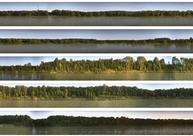 © Michael Aschauer
© Michael Aschauer
The Danube Panorama Project is an experimental approach to photographic mapping and cartography. It's goal is to produce a full panorama of the Danube's river sides by digitally slit-scanning its coastlines, resulting in a unique 'cross section' of contemporary Europe.
The Danube - "Europe's River of Destiny" - connecting Western, Central and Eastern Europe uniquely reflects the shifting relationships of its peoples, cultures and religions in its accumulated history and contemporary dimensions. It is as much a cultural as a geographic landscape. It will guide as a symbolic red line of this intense survey.
Michael Aschauer (AT)
15
Jul
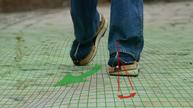 © Martin Frey
© Martin Frey
CabBoots is an innovative interface with a pedestrian navigation system. The information transmission process can be perceived tactilely, is intuitively understandable, and is applied to the part of the body most directly involved in the act of walking: the foot. Whereas conventional navigational devices normally communicate with the user on the auditory and visual levels, CabBoots utilizes the faculty of kinesthetic perception akin to walking on a well-trodden path.
Martin Frey (DE)
14
Jul
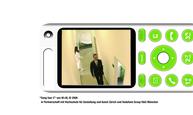 © Martin de Mattia/ Marc Weis
© Martin de Mattia/ Marc Weis
With their "Song for C", artistic duo M+M (Marc Weis and Martin De Mattia) has come up with a "film noir"-style detective story in which the boundary between fiction and real life tends to get a bit blurred.
The narrative gets the audience of cell phone users partaking of it involved in a drama entailing a variety of different seemingly authentic messages, transmitted images, clues and leads that turn passive viewers into active “voyeurs” of what is transpiring. It works like this: a female detective sends out mobile video dispatches to keep the audience of cell phone users updated about the progress of her investigation and, at the same time, to actively involve them in the case.
"Song for C"– a cinematic narrative for cell phones by M+M
Project Associates: Department of Technology of the HGKZ – School of Art and Design Zurich; Mobile Art Lab of Vodafone Group R&D, Germany
Martin de Mattia
Marc Weis
14
Jul
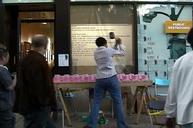 © Taylor Hokanson
© Taylor Hokanson
The Sledgehammer Keyboard communicates with a computer like its common counterpart - it is the user's experience that is unusual. Participants are invited to lay down their thoughts by striking its keys with a hammer. Each key requires a great force to activate, so users must be aggressive and concise in order to complete an idea.
The printing press, ballpoint pen and desktop computer all represent great leaps in the technology of communication. Each of these benchmarks made the writing process easier, at least in terms of procedure. But perhaps something is lost when an intellectual endeavor becomes too facile. If we put less physical effort into writing, is there also a corresponding shift in mental effort?
Taylor Hokanson (US)
13
Jul
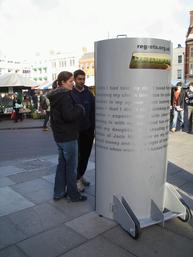 © Graham Budgett/ Jane Mulfinger
© Graham Budgett/ Jane Mulfinger
Regrets are often the conceptual vehicle of self-improving tendencies, but they are rarely communally active in any meaningful way. The Regrets team seeks to intervene and enable such interaction. In particular, remorse is posited here as a positive entity, incorporating recall, reflection, and learning.
Five custom mobile computer units roaming public space in and around a chosen city, community, or event, collect anonymously submitted regrets from the public, gathering and comparing them to comprise a sociological database of contemporary regret. Instant feedback to the individual user based on other contributors' similar concerns is algorithmically generated to 'share the burden'. Random selections of the regrets are made public via locally negotiated sites and existing signage, network, and broadcast facilities. The archive represents a glimpse of a given community at a particular time through the rubric of regret; its results available for future studies.
Graham Budgett (US)
Jane Mulfinger (US)
Blog Autoren:
Maria Hieslmayr Cornelia Sulzbacher Wolfgang Bednarzek Gerda Hinterreiter Didi Offenhuber Beta Lounge Artists Sonja Meller StWSt denCity.net
Suche:
Kategorien:
Conferences Animation Festival Events, Concerts & Performances Campus Exhibitions e-lobby Prix Ars Electronica
Recent Posts:
Photographs of the 2006 Festival Media lab thanks! Ars Electronica Center FM4 Live from Ars Electronica in Linz
Archiv:
Posts 180 - 160 Posts 160 - 140 Posts 140 - 120 Posts 120 - 100 Posts 100 - 80 Posts 80 - 60 Posts 60 - 40 Posts 40 - 20 Posts 20 - 0


